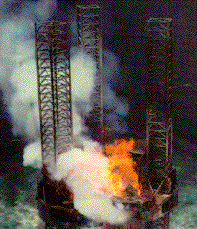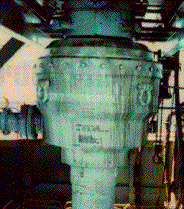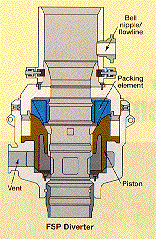![]()
Dangers | Rig Selection | Diverter Systems | Procedures | Training | Disaster Mitigation | Options | Next Article | |
 Part 7-Shallow Gas Blowouts: After underground blowouts,
shallow gas blowouts are the second most common type of blowout and the most common type
of surface blowout. Loss of rig, platform and life have resulted from shallow gas
blowouts. Invariably, the well is lost
Part 7-Shallow Gas Blowouts: After underground blowouts,
shallow gas blowouts are the second most common type of blowout and the most common type
of surface blowout. Loss of rig, platform and life have resulted from shallow gas
blowouts. Invariably, the well is lost
Michel Grepinet, Total Exploration Production Safety
Division, Paris,
L. Flak, former Wright, Boots
& Coots employee.
Little time and effort has been expended on shallow gas hazards, although industry has put a great deal of time and effort into analysis of kick control and blowout disaster mitigation,. Preparing for shallow gas can save lives and rigs. This article examines the dangers of shallow gas, precautions and procedures for shallow gas drilling, and disaster mitigation.
Two factors make shallow gas drilling a difficult challenge. First, unexpected pressure at the top of the gas bearing zone, due most often to the "gas effect" dictated by zone thickness and/or natural dip, can be significant. This pressure is usually unknown, seismic surveys being often unable to give an idea either about thickness or in-situ gas concentration. In more complex situations, deep gas may migrate upwards along faults. In Sumatra for instance, an influx could not be stopped even with 10.8 ppg mud at very shallow depth; the bit had crossed a fault plane. Second, low formation fracture gradients are a predominant factor in shallow gas operations.
Reduced safety margins. These two factors result in reduced safety margin for the driller. Minor hydrostatic head loss (swabbing, incorrect hole filling, cement slurry without gas-blocking agent), any error in mud weight planning (gas effect not allowed for), or any uncontrolled rate of penetration, with subsequent annulus over-loading, will systematically and quickly result in well bore unloading.
Shallow gas flows are extremely fast developing events. There is a short transition time between influx detection and well unloading, resulting in much less time for driller reaction and less room for error. Poor quality and reliability of most kick-detection sensors worsens problems.
Severe dynamic loads. Past history has disclosed the magnitude of severe dynamic loads applied to surface diverting equipment, and the high resulting failure probability. One of the associated effects is erosion, which adds high potential for fire and explosion from flow impingement on rig facilities.
Rig cratering. The risk of cratering is a major threat for bottom supported units. As it is impossible to eliminate them (most shallow gas-prone areas are developed from bottom supported units) emphasis should be put on careful planning and tight monitoring during execution.
When selecting a rig, two facts should be kept in mind. First, major shallow gas fields (in particular in Indonesia) have been explored, appraised and developed from bottom supported units.
Second, the most conspicuous disasters due to controlled shallow gas blowouts have involved drillships and semi-submersibles .
Two support types are particularly exposed and should be avoided: mat supported jackups and drillships. These rigs are not designed to ensure proper stability and/or to withstand heavy loads imposed by a boiling gas plume. They are, therefore, prone to take on water, catch fire, lose stability and eventually capsize.
Whatever the facility offered by semi-submersibles to move off location in case of uncontrolled gas flow, the questionable condition of the rig's mooring and release hardware, and the general unreliability of most semi-submersible surface diverting equipment, requires careful consideration.
Rig selection for shallow gas areas should take into account: Selection of a "safe" drilling location, according to seismic survey mapping Design of an engineered drilling program, with priority given to permanent hydrostatic control of the well
Comprehensive assessment of pre selected rigs, with final rig selection based on past experience and competence in shallow gas drilling, and also on diverting equipment fitness for purpose, layout, and structural ability to withstand a gas blowout long enough to permit a safe evacuation.

 Fig. 16. Model FSP bag diverter system provides automatic
venting when piston closes packing.
Fig. 16. Model FSP bag diverter system provides automatic
venting when piston closes packing.
Fig. 17. Flow Selector, left, directs flow from FSP Diverter to one of two opposed vent lines for down-wind line selection.
It is worth considering positive safety improvements which can be expected from more rational use of field proven diverter equipment. Traditional diverters. In the past, traditional diverters have failed due to shearing of insert-packer-element latching dogs caused by high thrust loads. Catastrophic loss of the Petromar 5 rig in the South China Sea resulted from this type of failure.
Bag diverters. By nippling up a field proven sealing element, e.g., standard spherical type bag preventer, with a properly sized diverter spool just above the conductor pipe, the following could be achieved:
This approach is commonly implemented by Total on North Sea platforms and in other areas, e.g., Indonesia, Thai land, Burmah, onshore and offshore, where there is shallow gas risk.
Subsea diverters. Most floating drilling units have diverting and venting equipment which cannot be easily and efficiently modified. Many oil companies and contractors have by-passed these systems and changed procedures; reliance is put on quick move-off in case of gas influx.
If the first point is debatable, the second one is questionable; mooring and release systems are not absolutely reliable. A recent case history disclosed the low level of operator confidence in the move-off option when, with a huge gas plume adjacent to a semi-submersible, an airborne evacuation was preferred.
The best floater, shallow-gas blowout protection is subsea diversion. Total and Sedco Forex, and a few others, have selected this option for exploration and appraisal drilling activities offshore Kalimantan (Indonesia). Although thrust loads, erosion, fire and explosion cease to be applied to surface equipment, care should, nevertheless, be given to closing speed of the subsea bag preventer and shear ram, and to riser (or wellhead) connector release time.
In addition, attention should still be paid to rig ESD systems, to the mooring lines release system, to firefighting and sprinkling capabilities, to location of the various remote controls, to avail able means allowing communications in a highly noisy environment, etc.
The following is a summary of the recommended approach, used and progressively improved during more than 20 years drilling in shallow gas prone areas.
Prior shallow seismic surveying. This is probably the only discipline which continues to progress and has the industry's unanimous support. Depending on field specifics, in particular, water depth and ease of access to the location, different techniques may be used, including HR surveys or 2-D and 3-D seismic surveys with specific reprocessing for shallow structures.
Common procedure is to position the rig outside the mapped hazardous area, which may entail directional drilling to reach the initial target. Pre selection of one or more gas-free locations is also recommended for relief well drilling should the need arise.
Shallow gas drilling requires, more than any other drilling or well servicing activity, comprehensive training for drilling personnel Pilot hole drilling.
This option is often considered, but for different reasons. The first is the need for logging to calibrate seismic survey information. This is often difficult, as soft, shallow formations tend to slough, making successive control trips and logging hazardous. The second reason claims that dynamic killing in a pilot hole might successfully stop a shallow gas blowout; this reasoning is now widely questioned. While it is difficult to kick a shallow gas sand from the effect of drilled gas only, drilled gas can be a serious problem with uncased shallower sands above the gas sand being drilled. Finally, the only benefit of a pilot hole is in limiting total volume of gas-filled porosity to be drilled. Limiting penetration rate in normal hole sizes may be just as viable an option.
Hydrostatic control. The permanent maintenance of hydrostatic control of the well is a must in any drilling situation. Selection of proper mud weight according to the gas effect assessment is essential. Failure to do so has caused major blowouts and capsizes. In addition, to maintain hydrostatic control, the following must be considered:
Careful planning will help minimize risk of an uncontrolled gas flow. How ever, there have been cases where little could be done to prevent it, e.g., in Malaysia and India, with highly tilted layers, or in Indonesia with deep gas migrating along faults.
On floating equipment, heavy mud can be pumped with returns lost to the seabed in riserless mode, or a lighter mud (designed according to the "gas effect" concept) may be pumped with the riser in place. The most important thing to remember is that the well will inevitably blowout, should seawater only be used to drill riserless shallow gas-bearing formations.
Shallow gas drilling requires, more than any other drilling or well servicing activity, comprehensive training for drilling personnel. Rig personnel should be taught about:
ENSPM-F1 (Pau, France) has launched, with the assistance of Total, a two hour "Shallow Gas Preparedness" training session.
Two tools should be provided to drilling personnel to help prevent disaster escalation. First, the operator should design, with the drilling contractor, a common and realistic emergency procedure. It should be remembered that "emergency" status follows very closely the influx detection. Most procedures do not contemplate shallow gas, and pre spud meetings are usually so short dated prior to start-up date that con tractor personnel have virtually no time to properly "digest" procedures or specific risks. Second, as many drills as are necessary should be authorized and carried out to ensure that emergency procedures are known, understood, well implemented, and that emergency equipment is working and reliable. Realism should prevail in emergency drills and procedures. Case histories have disclosed that, once the well has been unloaded, there is virtually no chance to recover control until it collapses by itself or depletes.
Depending on the type of available diverting equipment, two basic options are recommended:
Regarding support type, instructions should acknowledge the respective and inherent weaknesses of the following:
The best of all worlds would likely include a sound diverter system above a conventional pipe ram and choke line. This would allow initial well shut in and conventional circulation, if the kick were detected early. If the well were to broach, or the kick were not detected quickly, it could be reliably diverted. This is a controversial issue that is now under study by one major oil company after experiencing several large losses from diverted shallow gas blowouts.
HTHP Case History. A case history of successful control efforts on a significant
blowout of a HTHP producing well located off shore Louisiana. Covered will be failure of a
dynamic kill attempt and ultimate successful use of snubbing to allow pumping of reactive
plugs into the flow to block flow and kill the blowout.
![]() Next Article
Next Article
Bibliography
Adams, N. J., and G. G. Kuhlman, "Case history analyses of shallow
gas blowouts," IADC/SPE 19917, 1990.
Anon., API RP 64, "Recommended practices for diverter systems
equipment and operations," July 1, 1991.
Anon., AS. Veritas Research NIF course 7137, "Shallow gas kicks,
safety aspects related to diverter systems," June 1986.
Blount, E., and L. W. Abel, "Shallow gas blowouts."
Booth, J. W., "Use of shallow gas seismic data in relief well
planning," International Well-Control Symposium, Baton Rouge. Nov 27-29, 1989.
Bourgoyne, A. T., Jr., "The development of improved blowout
preventing systems for offshore drilling operations, Shallow gas hazards," MMS
report, Nov. 27, 1989.
Anon., B&P forum comments about West Vanguard accident inquiry
commission recommendations.
Grepinet, M., "The shallow gas threat, a mulhple challenge,"
IADC Well Control Conference, Paris 1993.
Goins, W C., and G. L. Ables, "Causes of shallow gas kicks,"
IADC/SPE 16128 presented at 1982 IADC Drilling Conference, New Orleans.
Guignon, J. G., "A unique approach for confirming the presence of
shallow gas in new offshore exploration areas," International Well-Control Symposium,
Baton Rouge, Nov. 27-29, 1989.
Moore, B., and T. Hamilton, "Shallow gas hazard, the HSE
perspective," Institute of Petroleum 1993.
Anon., NPD report, "Experience from the West Vanguard blowout:
required measures," 16-4, 1986.
Roche, J., "New tools afford more security from shallow gas,"Oil
and Gas Journal Feb. 19 1990
Anon., West Vangaurd report, Norwegian public report NOU 1986:16.
Yaaez, M., and J. Roche, "Pemex upgrades the Holkan after Campeche
Bay fire," Ocean Industry, July 1990.
The authors
Michel Grepinet joined TOTAL in 1975. Following five years on DP drillships, he managed drilling operations in various countries. In 1986, he transferred to the Alwyn field project in the UKCS to manage drilling operational safety. In 1989, he moved to company headquarters in Paris and expanded drilling operational safety operations. Earlier this year, he was appointed to lead the operational safety department for TOTAL exploration production safety division. Mr. Grepinet holds degrees in geological engineering and petroleum engineering.
Larry Flak's photo and biography appeared in Part 1 of this series.